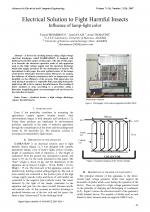| 2/2007 - 11 |
Electrical Solution to Fight Harmful Insects Influence of lamp-light colorBENMIMOUN, Y., FLAZI, S., TILMATINE, A. |
| Extra paper information in |
| Click to see author's profile in |
| Download PDF |
Author keywords
electrical device, a high voltage discharge, capture harmful insects
References keywords
References keywords will be displayed on the next page reload.
About this article
Date of Publication: 2007-11-03
Volume 7, Issue 2, Year 2007, On page(s): 45 - 48
ISSN: 1582-7445, e-ISSN: 1844-7600
Digital Object Identifier: 10.4316/AECE.2007.02011
Web of Science Accession Number: 000259903400011
Abstract
A device for catching insects, using a high voltage electrical discharge, called KAHRATRAP, is designed and build up by the first author of this paper. The aim of this paper is to describe the electrical operation mode of this apparatus such as the high voltage supply and the electrical discharge which this supply produces for the elimination of insects. We determined in this paper the most optimal colour of the lamps of the device which give the best results. Moreover, we analyze the influence of climatic parameters such as temperature and humidity on the efficiency of the process. This apparatus was used during 4 months in a vegetable field, operating during the night from 18h to 6h to capture harmful insects. The reading of insect numbers is done according to a procedure using a binocular magnifying glass, an entomologist tool and boxes for the collection of insects. |
| References | | | Cited By |
Web of Science® Times Cited: 0
View record in Web of Science® [View]
View Related Records® [View]
Updated 2 weeks, 5 days ago
We were unable to retrieve information about this paper in SCOPUS®.
Message: [Returned results: 0]
There are no citing papers in the CrossRef Cited-by Linking system.
Disclaimer: All information displayed above was retrieved by using remote connections to respective databases. For the best user experience, we update all data by using background processes, and use caches in order to reduce the load on the servers we retrieve the information from. As we have no control on the availability of the database servers and sometimes the Internet connectivity may be affected, we do not guarantee the information is correct or complete. For the most accurate data, please always consult the database sites directly. Some external links require authentication or an institutional subscription.
Web of Science® is a registered trademark of Clarivate Analytics, Scopus® is a registered trademark of Elsevier B.V., other product names, company names, brand names, trademarks and logos are the property of their respective owners.
Faculty of Electrical Engineering and Computer Science
Stefan cel Mare University of Suceava, Romania
All rights reserved: Advances in Electrical and Computer Engineering is a registered trademark of the Stefan cel Mare University of Suceava. No part of this publication may be reproduced, stored in a retrieval system, photocopied, recorded or archived, without the written permission from the Editor. When authors submit their papers for publication, they agree that the copyright for their article be transferred to the Faculty of Electrical Engineering and Computer Science, Stefan cel Mare University of Suceava, Romania, if and only if the articles are accepted for publication. The copyright covers the exclusive rights to reproduce and distribute the article, including reprints and translations.
Permission for other use: The copyright owner's consent does not extend to copying for general distribution, for promotion, for creating new works, or for resale. Specific written permission must be obtained from the Editor for such copying. Direct linking to files hosted on this website is strictly prohibited.
Disclaimer: Whilst every effort is made by the publishers and editorial board to see that no inaccurate or misleading data, opinions or statements appear in this journal, they wish to make it clear that all information and opinions formulated in the articles, as well as linguistic accuracy, are the sole responsibility of the author.



